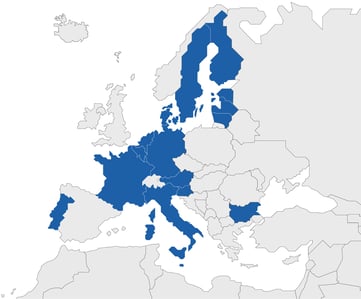Placing a product on the market in a given territory always entails some level of risk of infringement of one or more patents owned by a third party. To reduce this risk, it is important to carry out a freedom to operate (FTO) analysis, in which a patent attorney assesses whether a certain product or process falls within the scope of a valid and enforceable patent. This article will discuss how and why freedom to operate analyses have become even more important in light of the 2023 developments in European patent law.
The Unitary Patent and the Unified Patent Court
The most important update of the last half-century in the European patent world is constituted by a long-standing possibility that has now become a reality: on June 1, 2023, the Unified Patent Court Agreement (UPCA) entered into force, accompanied by the European Union Regulation establishing the Unitary Patent (UP). Although some large countries that are part of the European Patent Convention, such as the United Kingdom, Spain and Poland, are not part of these agreements, the Unitary Patent (or rather, the European Patent with unitary effect) and the new Court will provide coverage for 17 countries: Austria, Belgium, Bulgaria, Denmark, Estonia, Finland, France, Germany, Italy, Latvia, Lithuania, Luxembourg, Malta, the Netherlands, Portugal, Slovenia and Sweden. In the coming years, 7 other EU member states, which have already signed the agreement but have not yet ratified it, may join the new system as well. The next one will likely be Romania, which ratified the draft ratification law on November 16, 2023.


On the left: in red the contracting countries for the European patent, in dark blue and grey the countries of extension or validation: when a European patent application is granted, the patent must be validated in each desired country, one by one. On the right: in blue the countries covered in bulk with a Unitary Patent.
*Image source: European Patent Office
To describe it in a nutshell, thanks to the entry into force of the Unitary Patent, those who obtain the grant of a European patent will now be able to choose – as an alternative to the ‘classic’ European patent with validation on a country-by-country basis – to validate the patent in a unitary manner for the 17 countries indicated above, with potentially significant savings in terms of costs. For other states covered by the European patent but not by the unitary one, patent owners that select unitary validation will still be able to use the conventional validation procedure for those Member States.
As of December 31, 2023, approximately 1 in 6 European patents that have been granted since the new legislation came into force was validated as a unitary patent.
The Unified Patent Court (“UPC”) has, meanwhile, also opened its doors to hear disputes relating to, inter alia, the validity and infringement of Unitary Patents, as well as ‘classic’ European patents. Indeed, European patents are subject to the jurisdiction of the Unified Patent Court unless the patent proprietor(s) have filed a request to exclude their patent from the jurisdiction of the new Court, referred to as an opt-out. Currently, about 45% of the ‘classic’ European patents have been opted-out, while 55% remain under the jurisdiction of the UPC.
The jurisdiction of the UPC
As indicated above, the Unified Patent Court has jurisdiction not only over European patents with unitary effect, but also over ‘classic’ European patents for which an opt-out declaration has not been filed and supplementary protection certificates.
The UPC has jurisdiction over these patent rights in cases concerning:
- actual or threatened infringement;
- injunctions, as well as other protective and provisional measures;
- declarations of non-infringement;
- patent revocation and counterclaims for revocation;
- damages derived from provisional protection granted by a published European patent application; and
- use of an invention before the grant of a European patent or right of prior use.
Cases relating to the validity or infringement of conventionally validated European patents for which an opt-out declaration has been filed will instead be heard by national courts.
The possibility to file an opt-out of a ‘classic” European patent will only be available for the first 7 years of operation of the UPC, referred to as the transitional regime. This period may potentially be extended by the Administrative Council of the Court for another 7 years.
Freedom to operate: new risks and new opportunities
The Unitary Patent and the Unified Patent Court provide the potential for substantial savings and new opportunities, but also present challenges in risk management, both for patent owners and for those who provide products and services in Europe.
Given the territorial extension of the new patent system, a freedom to operate (FTO) analysis – in which a patent attorney assesses whether a certain product or process is at risk of patent infringement in certain jurisdictions – is, more than ever, a crucial and indispensable tool for reducing commercial and litigation risks.
This is due to the fact that the overall number of national territories covered by European patents will increase: at least some of the European patents that are granted and validated in a unitary manner would not have been validated in certain national territories under the conventional regime, in which companies generally tend to validate a European patent in a few important countries, such as Germany, France, the United Kingdom, and Italy. This is especially true for small countries covered by the Unitary Patent in which European patent validations were rare, such as the three Baltic countries, Bulgaria, Portugal, and Malta: companies operating in these countries, therefore, must worry about managing a risk that until now had been negligible.
Among other benefits, a freedom to operate analysis provides a company the opportunity to identify European patent applications that are relevant to its business that either may be granted, or that have been granted for less than 9 months, and then act accordingly. If there are appropriate grounds, the company may even move proactively to remove a potential risk of infringement and file an opposition procedure – which remains possible in the case of a European patent with unitary effect – before the European Patent Office (EPO) within 9 months from the date of publication of the grant of the European patent.
Tight procedural timeframes and speedy decisions
The utility of the freedom to operate opinion is even more important considering that the regulations governing the new Unified Patent Court establish very strict time limits for the parties, including the time for the respondent party to file its initial appearance in the action, and for the exchange of observations and replies within the procedure. Forget about the generous deadlines of some EU national courts: an action before the UPC can reach decision in just a year! This makes it even more advantageous for a commercial operator to have conducted a freedom to operate analysis before placing a new product or process on the market: with such a short timeline, it would be difficult to complete the necessary research and technical analysis within the procedural phase before Court.
Finally, the UPC regime also introduces new defensive tools into some national dispute systems. The best example of these are "protective letters", which for a fee of only € 200, allow an entity that fears being targeted for infringement of a certain patent within interlocutory, and potentially ex parte, proceedings, to get ahead of the risk and file facts and arguments in their defense before the Court. This is, naturally, yet another good reason to carry out a freedom to operate analysis before placing new products or processes on the market that may be targeted by patent owners.
Other benefits of freedom to operate analyses
In addition to the defensive reasons for undertaking an evaluation of one’s product with respect to one or more European patents that are currently in force, a freedom to operate analysis is able to highlight the specific characteristics of a product or process that may fall within the claims of such patent rights, paving the way for a potential design-around, i.e. a process in which, together with the patent attorney, one tries to find alternatives that do not infringe the features of the patent. This process allows a company to move from a situation of conflict to a situation in which the product can be freely produced and sold on the market.
Last but not least, a freedom to operate opinion that also includes a search for potentially conflicting patents would have the added benefit of allowing a company to obtain a higher degree of information about the research and development activities of its competitors, along with their technological strengths and weaknesses. This can, in turn, steer further product development and/or orient market strategy choices.





